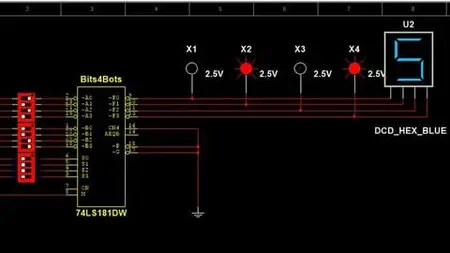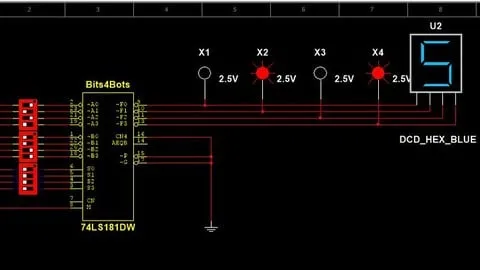Digital Logic Design With Lab Experiments
Last updated 8/2025
MP4 | Video: h264, 1920x1080 | Audio: AAC, 44.1 KHz
Language: English | Size: 4.17 GB | Duration: 22h 19m
Last updated 8/2025
MP4 | Video: h264, 1920x1080 | Audio: AAC, 44.1 KHz
Language: English | Size: 4.17 GB | Duration: 22h 19m
A Complete Guide to Logic Gates, Boolean Algebra, K-Map, Combinational and Sequential Circuits, Memories, Lab Content.
What you'll learn
Students will be able to apply the knowledge of number system,Boolean Algebra,Sequential circuits, Memory Elements used in the development of digital circuits.
The purpose to make students familiar with modern hierarchy of digital hardware and enlighten them the state-of-the-art computer hardware design methodologies.
The main emphasis is on the practical concepts and systematic synthesis techniques that can be applied to the design of practical digital systems
This course covers design of digital systems using standard, small, and medium scale integrated circuits.
Requirements
I created this course with absolute beginners in mind. You don’t need any prior knowledge of electronics, programming, or engineering—just curiosity and a willingness to learn.I created this course with absolute beginners in mind. You don’t need any prior knowledge of electronics, programming, or engineering—just curiosity and a willingness to learn.
Description
Course Description:Are you curious about how computers, digital systems, and electronic devices work at the most fundamental level? Welcome to Digital Logic Design, a comprehensive course that lays the foundation for understanding the inner workings of modern digital systems.This course is designed for students, engineers, and enthusiasts who want to master the core concepts of digital electronics. You’ll start from the basics — learning about binary number systems, logic gates, and Boolean algebra — and progress toward more advanced topics like combinational and sequential circuit design, flip-flops, counters, and finite state machines.Each topic is explained with clear theory, visual aids, truth tables, circuit diagrams, and practical examples to help you understand not just how digital systems work, but why they work that way. You’ll also learn methods for simplifying logic expressions using Karnaugh Maps and designing efficient digital circuits.By the end of the course, you'll be equipped with the skills to design and analyze digital circuits, which are critical in fields like computer engineering, embedded systems, and VLSI design.No prior experience with digital electronics is required — just curiosity and a willingness to learn. Join now and take your first step into the world of digital hardware design!
Overview
Section 1: Introduction
Lecture 1 Course Intro
Lecture 2 Course Contents
Lecture 3 How to download software
Section 2: Number System
Lecture 4 Intro
Lecture 5 Binary to decimal
Lecture 6 Binary to octal
Lecture 7 Binary to hexadecimal
Lecture 8 Octal to binary
Lecture 9 Octal to decimal
Lecture 10 Octal to hexadecimal
Lecture 11 Decimal to binary
Lecture 12 Decimal to octal
Lecture 13 Decimal to hexadecimal
Lecture 14 Hexadecimal to binary
Lecture 15 Hexadecimal to octal
Lecture 16 Hexadecimal to decimal
Lecture 17 Point value conversion
Lecture 18 Point value into decimal
Lecture 19 Arithmetic Operation
Lecture 20 Addition
Lecture 21 Multiplication
Lecture 22 Complements
Lecture 23 1's Complement
Lecture 24 2's Complement
Lecture 25 9's Complement
Lecture 26 10's Complement
Lecture 27 Subtracting using complement
Lecture 28 Binary Code Decimal(BCD)
Lecture 29 Excess 3 code
Lecture 30 Gray Code
Lecture 31 Binary to Gray Code
Lecture 32 Gray Code to Binary
Lecture 33 ASCII
Lecture 34 How to use ACSII in DLD
Section 3: Logic Gate
Lecture 35 Introduction
Lecture 36 AND Gate
Lecture 37 OR Gate
Lecture 38 Not Gate
Lecture 39 NAND Gate
Lecture 40 NOR Gate
Lecture 41 XOR Gate
Section 4: Boolean Algebra
Lecture 42 Introduction
Lecture 43 Associative Law
Lecture 44 Absorption Law
Lecture 45 Commutative Law
Lecture 46 Distributive Law
Lecture 47 Identity Law
Lecture 48 DeMorgan's Law
Section 5: Boolean Function
Lecture 49 Introduction
Lecture 50 Boolean Expression and Diagram
Lecture 51 Compliments in Boolean Function
Lecture 52 Axioms, Postulates
Lecture 53 Cut and Try Procedure
Lecture 54 Literals
Lecture 55 Proof By Law
Section 6: K-Map
Lecture 56 Introduction
Lecture 57 2 variable K-Map
Lecture 58 3 variable K-Map
Lecture 59 4 variable K-Map
Lecture 60 5 variable K-Map
Lecture 61 Don't care
Lecture 62 SOP,POS Introduction
Lecture 63 SOP
Lecture 64 POS
Section 7: Combinational Logic Circuits
Lecture 65 Introduction
Lecture 66 Half Adders
Lecture 67 Full Adders
Lecture 68 Full Adder using 2 half adder
Lecture 69 Half Subtractor
Lecture 70 Full Subtractor
Lecture 71 Full Subtractor using 2 half subtractor
Lecture 72 Multiplexer
Lecture 73 2x1 MUX
Lecture 74 4x1 MUX
Lecture 75 8x1 using 2x1 MUX
Lecture 76 8x1 using 4x1 MUX
Lecture 77 16x1 using 4x1 MUX
Lecture 78 Implementation of Boolean Function using MUX
Lecture 79 DeMultiplexer
Lecture 80 Application of DeMultiplexer
Lecture 81 1x16 DeMUX
Lecture 82 1x16 using 1x4 DeMUX
Lecture 83 1x8 DeMUX using boolean function
Lecture 84 Decoder
Lecture 85 Application of Decoder
Lecture 86 3 to 8 Decoder
Lecture 87 3 to 8 using 2 to 4 Decoder
Lecture 88 4 to 16 using 3 to 8 Decoder
Lecture 89 5to 32 using 3 to 8 Decoder
Lecture 90 Logic circuit implementation in Decoder
Lecture 91 Encoder
Lecture 92 Application of Encoder
Lecture 93 Decimal to BCD Encoder
Lecture 94 8 to 3 Encoder
Lecture 95 Priority Encoder
Section 8: Sequential Logic Circuit
Lecture 96 Introduction
Lecture 97 SR Latch using NOR Gate
Lecture 98 SR Latch using NAND Gate
Lecture 99 What is Clock
Lecture 100 Triggering Methods in FlipFlop
Lecture 101 Difference Between Latch and FlipFlop
Lecture 102 Intro to SR FlipFlop(Truth Table,Characteristics Table,Excitation Table)
Lecture 103 Introduction to D FlipFlop(Truth Table,Characteristics Table,Excitation Table)
Lecture 104 JK FlipFlop
Lecture 105 Truth Table,Characteristics Table,Excitation Table of JK FlipFlop
Lecture 106 Race Round Condition or Racing in JK FlipFlop
Lecture 107 Master Slave JK FlipFlop
Lecture 108 Intro to T Flipflop(Truth Table,Characteristics Table,Excitation Table)
Lecture 109 5 Steps for FlipFlop Conversion | JK to D FlipFlop Conversion
Lecture 110 T FlipFlop to D FlipFlop
Lecture 111 SR to JK FlipFlop
Lecture 112 SR to T FlipFlop
Lecture 113 Difference between Synchronous and Asynchronous Sequential Circuit
Lecture 114 Introduction to State Table, State Diagram and State Equation
Lecture 115 Design Procedure for Clocked Sequential Circuit
Lecture 116 Mealy and Moore State Machines
Lecture 117 Analysis of Clocked Sequential circuit (with D FlipFlop)
Lecture 118 Analysis of Clocked Sequential Circuit (with JK FlipFlop)
Lecture 119 State Reduction and Assignment
Lecture 120 ASM Chart for Moore State Machine
Lecture 121 Introduction to Counter
Lecture 122 Types of Counter
Lecture 123 3 Bit Up Asynchronous Counter
Lecture 124 4 Bit Asynchronous Up Counter
Lecture 125 State Diagram of Counter
Lecture 126 3 and 4 Bit Asynchronous Down Counter
Lecture 127 3 and 4 Bit Up/Down Ripple Counter
Lecture 128 How to Design Synchronous Counter | 2 bit Synchronous Up Counter
Lecture 129 3 and 4 bit Up/Down Synchronous Counter
Lecture 130 Ring Counter (Synchronous)
Lecture 131 Johnson's Counter (Synchronous)
Lecture 132 Introduction to Register
Lecture 133 Data Formats and Classification of Register
Lecture 134 Shift Register (SISO mode)
Lecture 135 Shift Register (SIPO&PIPO Mode)
Lecture 136 Shift Register (PISO Mode)
Section 9: Memory
Lecture 137 Design of ROM (Read only Memory)
Lecture 138 Programmable Logic Array (PLA)
Lecture 139 Programmable Array Logic (PAL)
Section 10: Lab Experiments
Lecture 140 Adder
Lecture 141 Multiplexer
Lecture 142 Decoder
Lecture 143 SR Latch
For everyone ( Electric Engineers, CS, IT ) who want to learn about digital login design



